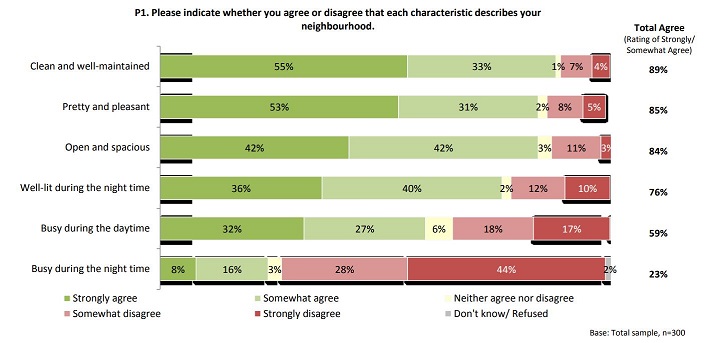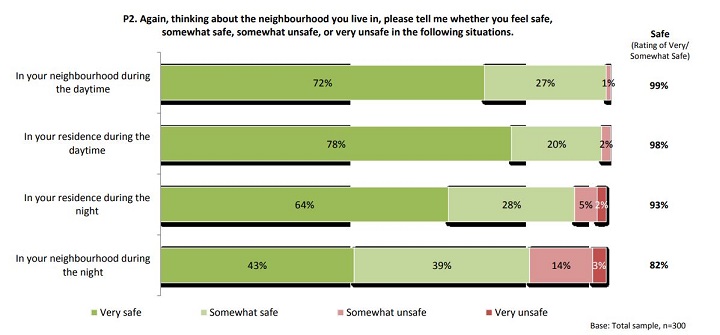It’s not perfect, but all is well in Kelowna, according to a survey regarding crime and public safety that was released by city council earlier this week.

The 40-page report was commissioned by the city, with a goal of understanding “residents’ perception of crime and safety in the City of Kelowna as a whole and within specific regions.”
In summarizing the report, the city said over eight in 10 respondents agree that their neighbourhood is clean and well-maintained, pretty and pleasant, and open and spacious.
The city also said nearly all respondents feel very safe or somewhat safe in their neighbourhood during the daytime (99 per cent). The city added that low crime rates emerge as the top reason for residents feeling their neighbourhood is safe relative to others in the city.
The city was divided into four regions for the poll, and, not surprisingly, the answers varied — sometimes widely — depending upon where one lived. The four regions, defined by postal codes, are Central (including downtown), Southwest Kelowna, North Kelowna and East Kelowna.
WATCH BELOW (Aired Aug. 16, 2016): Can you name the safest city in Canada?

For example, in Central Kelowna, 69 per cent said they felt safe in their neighbourhood during the night while 31 per cent said they didn’t.
In Southwest Kelowna, 88 per cent said they felt safe in their neighbourhood at night while 12 per cent said they didn’t feel safe. In North Kelowna, those numbers rose to 96 per cent and 3 per cent, respectively.

Get daily National news
More than 300 respondents within the city were polled, with poll organizers stating the margin of error was 5.7 per cent.
WATCH BELOW (Aired Aug. 16, 2016): Poll suggests many Canadians think Calgary is unsafe

When asked about other neighbourhoods, regional viewpoints contrasted sharply. East Kelowna respondents, at 46 per cent, said downtown Kelowna was less safe than other neighbourhoods. Yet only 16 per cent of Central Kelowna respondents listed downtown Kelowna as being less safe.
Regarding Rutland in East Kelowna, 29 per cent of North Kelowna respondents said it was less safe. But only 5 per cent of East Kelowna respondents listed Rutland as being less safe.
Regarding crime, the report said “only 4 per cent of residents citywide feel the level of property crime in their neighbourhood has decreased in the 12 months preceding the survey, whereas nearly one-quarter (24 per cent) believe property crime rates have increased.”
The report also said “residents citywide are more likely to believe the level of property crime in the city overall (50 per cent) has increased in the past 12 months compared to the level of property crime in their own neighbourhood (24 per cent) during the same time period.”
According to the poll, within their own neighborhood:
- Overall, eight in 10 (81 per cent) residents never or rarely worry about being robbed or mugged on the street, while two-thirds (67 per cent) say they never or rarely worry about having their car stolen or their home burglarized.
- Residents in Central Kelowna and East Kelowna tend to worry more often than those in North Kelowna and South Kelowna about neighbourhood crime-related activities.
- Males (86 per cent) are significantly more likely to indicate that they never or rarely worry about being robbed or mugged on the street than females (76 per cent).
- Residents with household incomes above $100,000 are significantly more likely than those with household incomes of less than $100,000 to indicate that they never or rarely worry about being robbed or mugged on the street.
- Residents ages 45-54 are the most likely to worry about drug trafficking (52 per cent) and burglary of their homes (47 per cent) than all other age groups.
According to the poll, respondents think the most important crime-related problems are breaking and entering/property crimes and drug use (45 per cent and 38 per cent respectively of respondents).
- Those in Central Kelowna are more apt to mention assault/violence than those in North Kelowna as the most important crime-related problem in the city.
- Residents in North Kelowna (60 per cent) are significantly more likely than those in Central Kelowna (38 per cent) and East Kelowna (37 per cent) to believe that breaking and entering/property crimes is the most important crime-related problem in the city.
- Residents age 65+ (50 per cent) are more likely to mention drug use as the top crime-related issue in the city than their younger.
The poll also noted that nearly three-in-ten respondents (28 per cent) have been a victim of a crime in the past year, and that there were no significant statistical differences between regions.
Further, of those crime victims, nine in 10 respondents (89 per cent) had experienced a property crime with six per cent having experienced a violent crime.
However, the poll noted that regional results were to be used with caution due to small sample sizes.
For more on the poll — which cost $12,810, according to the city — click here.




Comments